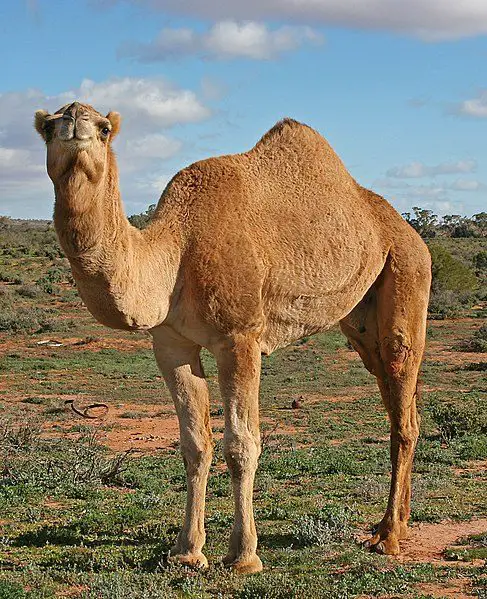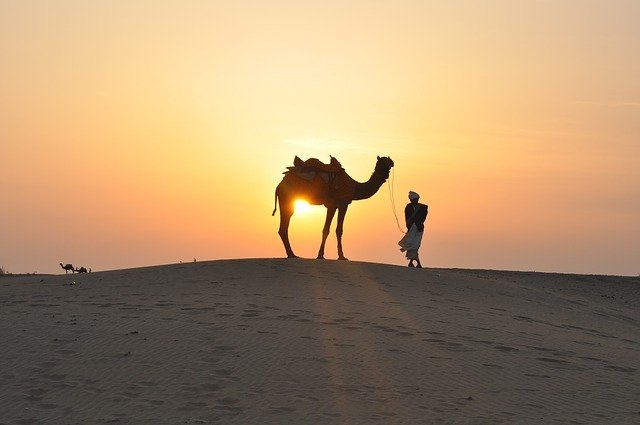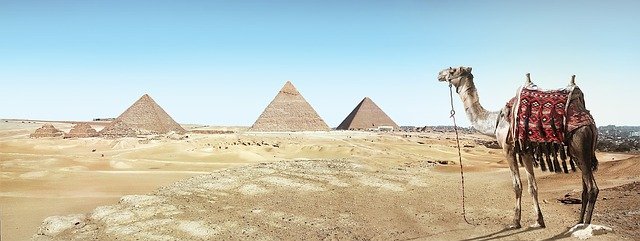Camel is a multipurpose animal and has long been domesticated by humans. It has been the fastest mode of transport in deserts due to which it is also known as the ship of the desert. It is also a beast of burden i.e. capable of transporting heavy loads over long distances. It has been valuable livestock providing food and textile. Due to so many qualities, Camels have been serving us for centuries, so it is very important to teach kids about this important animal. We have gathered a complete set of Camel Facts for Kids that will teach kids all about the camel and provide a lot of Camel information on one page.
Camel Facts For Kids
1. What is Camel
- A camel is an even-toed ungulate mammal that is found in arid locations. It is large with a long neck, long legs, and one or two humps on its back. It has cushioned feet allowing it to travel fast in deserts and natural adaptations that enable it to survive for long period without food and water.
- Camel is a domestic animal and also a source of food and textile when kept as livestock.

2. What Does A Camel Look Like – Camel Description
- Camel belongs to a diverse group of animals called ungulates (hoofed mammals).
- It is an even-toed ungulate, which means its third and fourth toes equally bear its weight.
- A camel has a small head, long legs, a muzzle with big lips, and either one or two humps on the back.
- A camel is an oddly-formed giant animal that lacks regularity in its appearance.

3. Scientific Name of Camel
- The scientific name of the camel is “Camelus”.
4. Camel Names
- Camels have a special place in Arab culture and tradition.
- In the Arab world, special names are assigned to camels based on their developmental stage, size, or other characteristics.
- Some of the names are:
- “Al Fahal” – male camel common name
- “Addawaser” – big sized camel
- “Al Bikra” – a virgin female camel
- “Al Rahila” – young camel capable to ride people
- “Al-Sharif” – a slow and tired camel
- “Al Shamlal” – lower weight and fast-moving camel
5. Camel Classification
| Kingdom: | Animalia |
| Phylum: | Chordata |
| Subphylum: | Vertebrata |
| Superclass: | Gnathostomata |
| Class: | Mammalia |
| Subclass: | Theria |
| Infraclass: | Eutheria |
| Super Order: | Cetartiodactyla |
| Order: | Artiodactyla |
| Family: | Camelidae |
| Tribe: | Camelini |
| Genus: | Camelus |
| Species: | Camelus bactrianus Camelus dromedarius Camelus ferus |
6. How Big Are Camels – Camel Size
- Adult full-grown camels have about 3 meters (10 feet) body length, a height of 1.8 meters at shoulders, and 2 meters at the hump.
- Bactrian camels have a bodyweight of about 660 to 2,200 pounds (300 to 1,000 kg) while Dromedary camels have 660 to 1,320 pounds (300 to 600 kg).
7. How Tall Are Camels – Camel Height
- The standing height of an adult full-grown camel is up to 7 feet 1 inch (2.15 meters) at the hump while 6 feet 1 inch (1.85 meters) at the shoulders.
- The standing height of a Bactrian camel at shoulder ranges from 5.9 to 7.5 feet (1.8 to 2.3 meters).

8. Camel Hump Facts
- Camels have prominent bumps on their back.
- Dromedary camels have a single hump on their back while Bactrian and Wild Bactrian camels have two humps.
- In old times, it was believed that camels store water in their humps, however, a camel’s hump is a reservoir of fats, not water.
9. Why Do Camels Have Hump On Their Back
- A camel’s hump is a storage place for fats – an energy-rich compound that provides the energy of 9 calories per gram.
- Camels utilize their humps’ fats as an energy source when food is scarce.
- That is why a well-fed camel has an upright and hard hump while the same camel will have a flexible and bent hump after a long journey, particularly in the desert.
10. What Is In A Camel Hump – What Do Camels Store In Their Hump
- Camels store fats in their humps.
Do Camel Store Water In Their Hump
- No, camels do not store water in their humps, but rather, they store fats in their humps.
- It was a misconception among the people during old times that camels store water in their humps.
How Many Humps Does A Camel Have
- Dromedary camels have a single hump.
- Bactrian and Wild Bactrian camels have two humps.
11. Camels Water Storage Facts
- Camels are capable to drink up to 53 gallons (200 liters) of water in about 3 minutes, which is stored in their bloodstream.
- They have oval-shaped red blood cells (RBCs) rather than round-shaped, which make their flow easier in case of dehydration.
- The oval-shaped RBCs also effectively resist the osmotic changes when camels intake a high amount of water at a time.
- Similarly, camels utilize their humps’ fats for energy when food is not available.
- During the metabolic process of animals, the conversion of 100 grams of fats into energy, produces 100 grams of water which is called metabolic water.
- Their fat storage is in the hump rather than their whole body which protects them from being overheated, so they do not sweat much and conserve water in their bodies.
12. Features Of Camel
- Some special features of camels include:
- They have long feet that help them in walking easily on the sand.
- Their long eyelashes protect their eyes even in sandstorms.
- They can close and open their nostrils which helps them to prevent sand from entering their nose.
- Their humps are reservoirs of fats that help them to survive for a long time without food.
- Their body temperature changes within the range of 34 to 41.7 degrees centigrade, which prevents them from sweating too much and helps conserve water in hot climates.
Camel Lips
- Camels have two lips.

- Their lips are specially adapted through which they can put thorny herbs in their mouth without hurting their lips.
Camel Eyes
- Camels have two eyes of usually brown color.
- Each eye is surrounded by three eyelids, two of which have eyelashes while the most inner one does not have any lashes.
- Just above the eyes, they have thick and shaggy eyebrows, which protect their eyes from the intense sunlight in the desert.
Why Do Camels Have Long Eyelashes – Camel Eyelashes
- Camels have a pair of two long eyelashes, which protect their eyes from sand in the desert.
Camel Ears
- Camels have a pair of ears and a very strong sense of hearing.
- Their ears are covered with shaggy hair from both inner and outer sides.
- This hair works as a shield against dust and sand.
- Camels can also bend their ears to the backside to prevent blowing sand from entering.
Camel Nostrils
- Camels have muscular nostrils.
- They can close it to prevent sand from being entering the nasal passage.
- Camels also use their nostrils to trap the moisture from the exhaling air as a means of conserving water.
- Camels also have the capability of cooling the inhaled air to condense the moisture.
Camel Eyelids – How Many Eyelids Do Camels Have
- A camel has 3 eyelids around its eyes.
- The two outer eyelids have eyelashes while the innermost eyelid does not have lashes.
- This inner eyelid is very special as it does not open and closes up and down but rather from the sides.
- It works like a wiper and cleans all dirt from their eyes.
- It is thin enough that camels can see even if it is closed, and that is how camels are capable of finding their way in sandstorms.
- On stormy and windy days, camels close these inner eyelids to protect their eyes from sand.
Camel Fur – Do Camels Have Fur
- Camels have thick, shaggy fur of light brown to dark brown color.
- In summer, the fur color lightens which reflects sunlight and acts as an insulator to protect the body from overheating.
- Fur is also a means of water conservation as camels with fur sweat about 50% less than shaved camels.
- Fur also keeps their body warm in cold climatic conditions.
Camel Feet – A Camel’s Foot – Do Camels Have Toes
- Camels have four large and specially designed feet.
- Each foot is made up of two toes which consists of a wide pad of flexible fibers and fats surrounded by a thick lathery cover.
- Each toe has a nail which is a partially formed hoof.
- Both toes spread when they place it on the ground.
- Such feet help camels to walk easily on the sand and protect them from sinking.
Why Do Camels Have Large Feet
- Camels can easily walk in the sand due to their large feet.
- Large feet protect them from sinking in the desert sand.
How Many Toes Does A Camel Have
- Each foot of a camel has two toes.
- Camels have four feet, so a camel has collectively 8 toes.
Camels Feet Adaptation
- Camel feet are specially adapted for walking on the desert sand.
- Their wide feet handle their weight and do not let them sink in the sand.
Why Do Camels Have Long Legs
- The long legs of camels keep away their body from the heat of desert sand.
- Long legs are one of the many factors that protect them from overheating.
13. How Do Camels Walk
- Camels walk by moving their front and back legs of the same sides together.
- This type of movement produces a rocking motion which is known as “pacing”.
14. Camel Evolution Facts for Kids
- Protylopus were the earliest camels that lived during the Eocene epoch (56 to 33.9 years ago) in North America.
- All modern camels are the descendants of one direct ancestor “Procamelus”, which lived in the era of the final Miocene and initial Pliocene.
- Camels of North America spread into the other parts of the world during the Great American Interchange.
- They went into South America through the Isthmus of Panama and to the Asian continent through the Bering Land Bridge.
- The North American indigenous camel became extinct about 12,000 to 10,000 years ago due to the arrival of Native Americans from Asia into North America.
15. Where Do Camels Come From
- North America is the origin place of camels from where they spread into Eurasia and South America.
16. Camel Behaviour Facts for Kids
- Camels show certain behaviors, for example:
- They graze every day for about 6 to 8 hours and then chew cud (partially digested food) for the next 6 to 8 hours.
- Wild camels have extremely intense eyesight, which makes them able to detect danger from a distance of 2 to 3 miles and flee.
- When they are excited, they often spit out cud.
- Camels use their canine teeth as a weapon.
- Their aggressive fights often led to the death of both fighters.
17. Camel Domestication Facts for Kids
- The history of dromedary camels’ domestication is around 3,000BC.
- Nomads in the South Arabian countries and Somalia first domesticated them.
- Bactrian camels were initially domesticated around 2,500 BC in Central Asia.
- Today, most of the camels are domestic and a very small portion of their population is found in the wild, which is also ferals (wild animals descended from domesticated ancestors).
18. Different Types Of Camels – Camel Breeds
- There are three main breeds or types of camels, that is:
- Dromedary camel (Camelus dromedarius)
- Bactrian camel (Camelus Bactrianus)
- Wild Bactrian camel (Camelus ferus)
- A hybrid camel is a hybrid offspring of the dromedary and Bactrian camels.
- Cama is another hybrid offspring of a male dromedary and female Llama that was first produced in Dubai in 1998 through the technique of artificial insemination.

Wild Camels
- The only species of camel that exist in the wild is “The Wild Bactrian camel”.
- No other species of camel exist in the wild for about two thousand years.
- In Australia, a great number of feral camels live in the wild, but actually, they are the offsprings of domesticated ancestors.
19. What Is A Two Humped Camel Called – Two Humped Camel
- A two-humped camel is called a “Bactrian camel”.
- The “Wild Bactrian camels” species also have two humps.
20. Bactrian Camel
- Bactrian camels (Camelus Bactrianus) are also called two-humped camels as they have two humps.
- This camel species is indigenous to the countries of Central Asia.
- Their current population is nearly two million and exists basically in domestications.
Wild Bactrian Camel
- Wild Bactrian camel (Camelus ferus) is a camel species that closely resemble the Bactrian camel.
- Like Bactrian camels, they have two humps, are massive in size, and are indigenous to Central Asia.
- Wild Bactrian camels inhabit some regions of northern China and the Gobi desert (southern part of Mongolia).
- This camel species has been listed as critically endangered by several organizations like IUCN and the London Zoological Society.
- The current surviving population of wild Bactrian camels is about 1,400 only.
Why Do Some Camels Have Two Humps
- Bactrian and Wild Bactrian camels have two humps while Dromedary camels have one.
- The extra one hump makes Bactrian camels stronger to endure extremely harsh conditions of cold and warm climates, in which the Dromedary camels with one hump would not be able to live.
- That is why Bactrian camels can live in freezing environments (-40 degrees centigrade) as well as in extremely warm (49-degree centigrade).
21. Dromedary Camel – Is A Dromedary A Camel
- Yes, the Dromedary camel (Camelus dromedarius) is a camel species that have a single hump.
- This species of the camel is also sometimes called the Arabian camel and is the smallest of all the three camel species.
- Dromedary camels exclusively exist in domesticated form.
One Humped Camel
- Dromedary camels have one hump and are sometimes called one-humped camels.
- It is the most populous species of camel that is found all over the world.
22. Difference Between Dromedary and Camel
- A Bactrian camel is also called just “Camel”.
- The following are the differences between the dromedary and Bactrian camel.
| Feature | Dromedary | Camel or Bactrian Camel |
| Number of humps | one | two |
| Body size | Greater but small in size than Bactrian | greater |
| Neck size | Longer neck | Short neck |
| Leggs length | Longer | Shorter than dromedary |
| Fur | Thin and shorter | Thick and longer |
| Bodyweight | Less than Bactrian | More heavy |
| Habitat | Live in warmer and temperate climates | Live in extreme conditions like above 40 degrees centigrade in summer and -40 degrees centigrade in winter |
| Life span | 40 to 50 years | Have a 20 to 40 years life span in captivity while living longer in the wild for up to 50 years. |
| Behavior | More aggressive | Less aggressive |
23. Three Humped Camel Facts for Kids
- A three-humped camel does not exist in reality.
- A three-humped camel is sometimes shown in faction movies and cartoons.
24. Indian Camel
- About 80% of the total population of camels in India is found in the Rajasthan state.
- About all of the camels are dromedaries.
- The number of Bactrian camels in India is approximately “100”.
25. Asian Camel
- All three types of camels are found in Asia.
- Wild Bactrian camels are indigenous to the Central Asian steppes.
- All the population of Bactrian camels is confined to the Asian countries, which also got its name from “Bactria”, a historical region in Central Asia.
26. What Do Camels Eat – Camels Diet Facts for Kids
Are Camels Herbivore
- Yes, camels are herbivores as they exclusively eat materials of plant origin.
- Camels are herbivorous and eat vegetation.
- Camels eat about each type of vegetation.
- Their diet ranges from grasses and dry plants to excessively thorny and salty bushes and plants that other animals mostly avoid.
- Being capable of eating huge thorns without any harm to their mouth is one of the special adaptations of camels that helps them to survive in the tough climate of the desert.
What Do Camels Eat in The Desert
- In the desert, camels eat dried plants, thorny bushes, and other desert plants.
- Their masters also feed them often with grains, oats, and wheat.
- In case of severe food scarcity, camels eat everything they find, even the cloth or lather of their master’s tent.
27. How Much Water Does A Camel Drink
- Camels drink different quantities of water in different conditions.
- In dry and hot climates, a very thirsty camel can drink about 200 liters of water in one day.
- At a time, they can drink up to 46 liters of water.
- When water is largely available, camels often drink water daily.
- Camels often do not drink water for months in cold conditions and the abundance of green vegetation.
How Many Gallons Does A Camel Drink
- An extremely thirsty camel can drink about 53 gallons of water per 3 minutes.
- In fewer thirst conditions, camels drink about 32 gallons of water at a time.
28. How Many Stomachs Does A Camel Have
- Camels have only one stomach, which is divided into three chambers.
- Each chamber performs a different function, so it is often said that camels have three stomachs.
- Camels ruminate (chew cud or semi-digested food), but unlike ruminants, they have three chambers in their stomachs rather than four.
- Due to this reason, camels are considered semi-ruminants.
29. Where Do Camels Live – Camels Habitat
- Dromedary camels are found throughout the arid and semiarid areas of the world in domesticated form.
- Most of their populations live in the desert environments of the Sahara Desert, Middle East, Southwestern Asia, and in the regions of the Indian desert.
- Wild dromedary camels descended from domesticated ancestors are found in a great number in Australia.
- Bactrian camels are indigenous to the rocky desert regions of East and Central Asia.
Why Do Camels Live in The Desert
- Camels have a lot of special structural adaptations, which helps them to survive in the hard conditions of the desert.
- They can tolerate the climate of the desert and that is why camels live in the desert.
Where Do Bactrian Camels Live
- Bactrian camels are also live mainly in the domesticated form.
- They are found mostly in the countries of East and Central Asia.
- A great part of its population is currently found in the cold desert areas of China, Mongolia, Kazakhstan, Russia, and Uzbekistan.
Camels In Egypt
- The history of camels in Egypt is about 500 to 600 BC.
- However, camels were introduced on large scale in Egypt by foreign conquerors like Persians, Assyrians, and Alexander the Great.
- Both types of camels (dromedary and Bactrian) were used in Egypt from about 525 to 343 BC as a basic means of transportation.

Camels In Australia Facts
- In Australia, there is a feral population of camels in which most are dromedaries and some are Bactrians.
- Camels were imported into Australia in the 19th century from Afghanistan and British India for construction and transport.
- During the early years of the 20th century, vehicles took the place of camels as a means of transportation.
- So most of the camels were released into the wild, where their feral population fastly increased.
- In 2009, a management program of AS$19 million was funded to reduce the feral population of camels.
- After the completion of that program, their population reduced to about 300,000 in 2013.
- The camel industry of Australia export camel meat into Europe, Japan, and the USA, and sometimes live camels into UAE, Saudi Arabia, and Malaysia.
Are There Camels In Africa
- Yes, there are camels in Africa.
- A significant part of the world’s camel population exists in Africa.
- Most of the camels are found in the East African peninsula “the Horn of Africa” (it includes the countries of Somalia, Djibouti, Ethiopia, and Eritrea), and North African countries that bordered with Sahara Desert (such as Morocco and Egypt).
Sahara Desert Camel
- In the Sahara Desert, camels are used as the main mode of transportation.
- About all of the camels in the Sahara Desert are dromedaries.
30. Camel Lifecycle
- A camel becomes sexually mature at the age of 2 to 3 years, however, do not give birth before the age of 5.
- A female gives birth once about every 2 to 3 years.
- The gestation period of camels is 12 to 12.5 months.
- Camels usually give birth to only one calf.
- Calves are fed by the mother milk for about 1 year.
- Camels live for 40 to 50 years.
31. How Long Do Camels Live – Camel Lifespan Facts for Kids
- The average lifespan of camels is up to 40 – 50 years.
32. Female Camel
- A female camel is called a “Cow”.
- Females feed baby camels for about one year.
33. Baby Camel – What Does A Baby Camel Call
- Baby camels are called calves.
- A male baby camel is called a “Bull Calf”, and a male camel is called a “Bull”.
- Baby camels are born with open eyes and also have a thick coat of fur.
- Calves do not develop humps until they start eating vegetation.
- They reach sexual maturity at the age of 3 years.
34. How Fast Can A Camel Run
- For short bursts, a camel can run at a speed of up to 40 mph (65 km/h).
- While they can run at the speed of about 25 mph (40 km/h) for long distances.
34. Camel Adaptations – Camel Structural Adaptations
Camels have the following adaptation:
- The hump of a camel is a fat reservoir, which protects its body from excessive heat absorption and minimizes insulation in its whole body, and also provides energy in case of food scarcity.
- Camels’ fur color becomes lightened in summer which reflects most of the sunlight and protects their body from overheating.
- A camel’s body is capable to change its temperature during the day and night. The range of their body temperature is 106 degrees Fahrenheit at the day and 92 degrees Fahrenheit at the night.
- All the above three adaptations protect them from excessive sweating and help them to conserve water.
- Camels also have red blood cells (RBCs) of an oval shape rather than round, which can flow in the state of dehydration and can also withstand higher osmotic changes when a camel drinks a large amount of water at a time.
- Their nostrils trap moisture from the exhaled air and their body reabsorbed it to conserve water.
- Camels have two sets of eyelashes and a special transparent inner third eyelid, which protect their eyes in the blowing sand of the desert.
- The mouth of camels has a leathery and very thick lining due to which they can eat thorny plants without any harm to their mouth.
- In the kidneys of camels, the ratio of the cortex to the medulla is 1:4 due to which it has extremely high water reabsorbing efficiency and reduces the volume of urine in hard conditions of the desert.
Camel Behavioral Adaptations
- Camels lie down in such a direction that their body becomes less exposed to the sun to avoid fast-heating.
- They search for food at night at a lower temperature to reduce water and energy loss.
44. How Do Camels Survive in The Desert
- Camels have many physiological adaptations which help them to survive in the desert.
45. Where Do Camels Store Water
- Camels store water in their bloodstream and body tissues.
46. Do Camels Spit – Why Do Camels Spit
- Yes, camels spit when provoked and it is considered as a sign of their excitement.
47. Camel Riding
- Camels have been used for riding for thousands of years.
- In deserts, camels were the only way of transport.
- Camels were used by the Border Security Force of India till 2012.
48. How Long Does A Camel Go Without Water
- Camels can survive without water for about six to seven months in winter.
49. Why Camel Is Called Ship Of The Desert
- A camel is called the ship of the desert as it is the only mode of transportation for humans in the deserts.
- No other animal species can move easily and fastly in the desert-like camels.
Why Does A Camel Walk Easily On Sand
- Camels have large pads like feet, which spread when touching the sand.
- Such feet protect them from sinking and allow them to easily walk on sand.
50. How Much Weight Can A Camel Carry
- A camel can carry 170 to 270 kg (375 to 600 pounds) weight on its back.
51. What Noise Does A Camel Make
- Camels make a noise like “blo-blo-blo”.
52. What Are Camels Used For – Uses Of Camels To Humans
- Camels have been used for different purposes for thousands of years.
- The first camel saddle had been used about 1200 BC.
- The use of camels in the military started about 853 BC when camel cavalries were used in the Battle of Qarqar.
- The Mongolian nomads and desert tribes use the hair of camels for clothing, tents, and other accessories.
- In deserts, camels are till now used as a basic means of transportation.
- The milk and meat of camels are staple food for the desert tribes. Camels meat is eaten throughout the Muslim world, especially in Arab and African countries.
53. How Do Camels Protect Themselves
- Camels protect themselves in several ways like;
- Camels kick their predators with their long and strong legs.
- In case of a threat, camels spit cud on predators.









